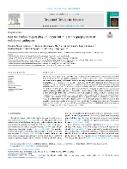Red fox (Vulpes vulpes) play an important role in the propagation of tick-borne pathogens

Autor
Lesiczka, Paulina Maria
Rudenko, Natalia
Golovchenko, Maryna
Datum vydání
2023Publikováno v
Ticks and Tick-Borne DiseasesRočník / Číslo vydání
14 (1)ISBN / ISSN
ISSN: 1877-959XMetadata
Zobrazit celý záznamKolekce
Tato publikace má vydavatelskou verzi s DOI 10.1016/j.ttbdis.2022.102076
Abstrakt
The red fox (Vulpes vulpes) is the most widespread free-living carnivore in the world. Over the years, foxes have been recognized as hosts for a number of tick-borne pathogens. However, their role as reservoirs for zoonotic tick-borne diseases is poorly understood. The aim of our study was to investigate tick-borne pathogens in the red fox population in the Czech Republic. Out of 117 red foxes, 110 (94.02%) individuals tested positive for the presence of at least one pathogen by the combined PCR and sequencing approach. Hepatozoon canis was the most frequently detected pathogen (n = 95; 81.2%), followed by Babesia vulpes (n = 75; 64.1%). Babesia canis was not detected in our study. Four (3.42%) red foxes were positive for Candidatus Neoehrlichia sp., 3 (2.56%) for Anaplasma phagocytophilum, and one red fox (0.85%) tested positive for the presence of Ehrlichia sp. DNA. Overall, DNA of spirochetes from the Borrelia burgdorferi s.l. complex was detected in 8.6% of the foxes and B. miyamotoi in 5.12% of the samples. As a carnivore found in all ecosystems of Central Europe, foxes obviously contribute to transmission of tick-borne pathogens such as A. phagocytophilum, B. burgdorferi s.l., and B. myiamotoi. In addition, foxes apparently harbour a community of pathogens, associated with this host in local ecological context, dominated by H. canis and B. vulpes (possibly also Candidatus Neoehrlichia sp.). These species have the potential to spread to the domestic dog population and should be included in the differential diagnosis of febrile diseases with hematologic abnormalities in dogs.
Klíčová slova
Anaplasma, Babesia, Borrelia, Carnivores, Tick-borne pathogens, Vulpes vulpes, Candidatus Neoehrlichia, Ehrlichia
Trvalý odkaz
https://hdl.handle.net/20.500.14178/1834Licence
Licence pro užití plného textu výsledku: Creative Commons Uveďte původ-Neužívejte dílo komerčně-Nezpracovávejte 4.0 International







